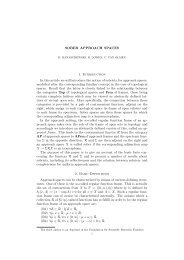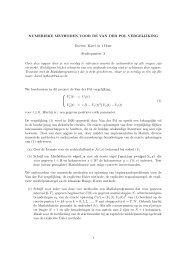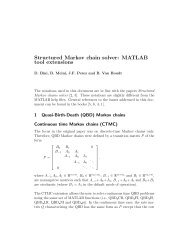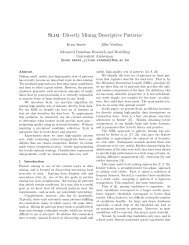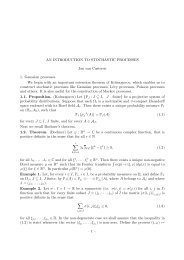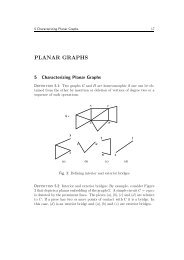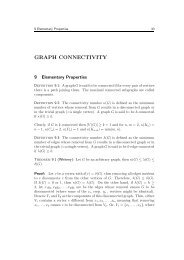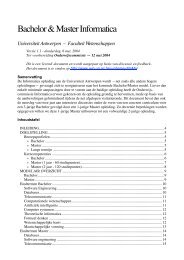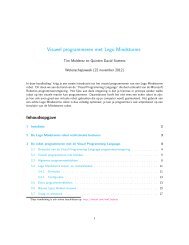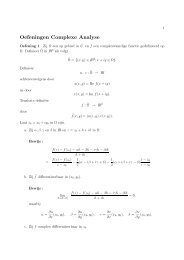Practical Rational Interpolation of Exact and Inexact Data Theory ...
Practical Rational Interpolation of Exact and Inexact Data Theory ...
Practical Rational Interpolation of Exact and Inexact Data Theory ...
You also want an ePaper? Increase the reach of your titles
YUMPU automatically turns print PDFs into web optimized ePapers that Google loves.
5.2. Parameterizations 61<br />
(s1,s2)-degree ≥ 0 such that the linearized rational interpolation conditions<br />
f(xi)d(xi) − n(xi) = 0, i = 0,... ,j (5.2)<br />
are satisfied.<br />
We already briefly touched this kind <strong>of</strong> problem setting in Section 2.1,<br />
where the barycentric form was used by Antoulas <strong>and</strong> Anderson [AA86] for<br />
obtaining a solution for (5.2) <strong>of</strong> minimal (0,0)-degree. In the discussion here<br />
we restrict ourselves to one particular, so-called single step method, where<br />
one is interested to compute a sequence <strong>of</strong> neighboring entries in the table <strong>of</strong><br />
rational interpolants (or in case <strong>of</strong> blocks, a maximal subsequence) [BL97].<br />
In each step one more interpolation condition is added, hence each time 0 ≤ j<br />
is increased by one. It is shown in [VBB92, VBB90] that all polynomial<br />
couples (n(x),d(x)) <strong>of</strong> a certain (s1,s2)-degree ≤ α that satisfy (5.2) can<br />
be parameterized by two polynomial couples vj(x) = (nj,v(x),dj,v(x)) <strong>and</strong><br />
wj(x) = (nj,w(x),dj,w(x)). Therefore (vj(x),wj(x)) is called a basic pair.<br />
Denote by Rivj <strong>and</strong> Riwj the linearized residual at xi <strong>of</strong> the polynomial<br />
couple vj(x) <strong>and</strong> wj(x) respectively<br />
Rivj = f(xi)dj,v(xi) − nj,v(xi)<br />
Riwj = f(xi)dj,w(xi) − nj,w(xi).<br />
The steps to obtain a possible choice for such a basic pair are given in<br />
Algorithm 5.2.1. For each 0 ≤ j, a basic pair (vj(x),wj(x)) is constructed<br />
from a basic pair (vj−1(x),wj−1(x)) <strong>of</strong> the previous level. In each step,<br />
both vj(x) <strong>and</strong> wj(x) solve the linearized rational interpolation problem for<br />
or equivalently<br />
{xi} j<br />
i=0<br />
Rivj = 0, i = 0,... ,j<br />
Riwj = 0, i = 0,... ,j.<br />
The algorithm is such that the polynomial couple vj(x) is always <strong>of</strong> minimal<br />
(s1,s2)-degree ≥ 0. In fact vj(x) is a minimal degree solution for some<br />
rational interpolant in the table <strong>of</strong> rational interpolants. Hence, vj(x) need<br />
not be irreducible, but if vj(x) contains common factors, they are unattainable<br />
points. It is also shown in [VBB92, VBB90] that all solutions <strong>of</strong> the<br />
(non-linear) rational interpolation problem <strong>of</strong> minimal (s1,s2)-degree are<br />
also parameterized by a linear combination <strong>of</strong> vj(x) <strong>and</strong> wj(x).<br />
Example 5.2.1. Let us consider (s1,s2) = (0,0) <strong>and</strong> the case <strong>of</strong> a normal<br />
table <strong>of</strong> rational interpolants, i.e. without blocks. Figure 5.2 illustrates



